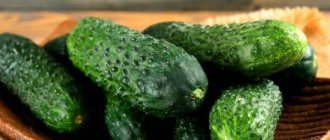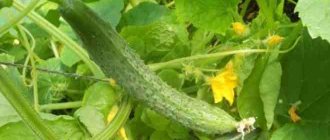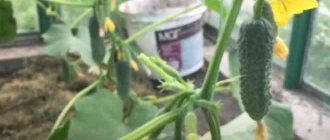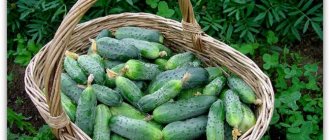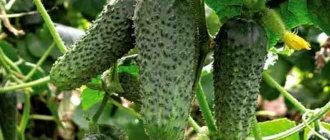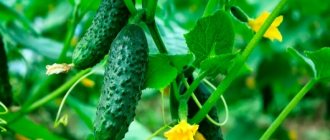It is worth starting the description of the Atlet cucumber variety with an important feature - the plant is grown in greenhouses. The hybrid was bred in 1999 by Russian breeders. In 2002, the variety was included in the State Register of Plants of Russia. One of the most widely used varieties with a long fruiting period. Suitable for growing in any climate zone.
The Atlet F1 variety has gained popularity among farmers and gardeners due to its high productivity. The high taste qualities were appreciated in the agricultural products market. In areas with a temperate climate, cucumbers are grown under film cover or in greenhouses.
Description of Atlet cucumbers
Proper planting of the variety will ensure a good harvest. The formation of a bush contributes to better pollination of the subspecies by bees. In terms of culinary use, Atlet cucumbers are classified as a salad type. The structure of the pulp does not allow canning or pickling of fruits.
The yield when grown in glass greenhouses reaches 33 kg per 1 m².
Bushes of the Atlet variety are described as indeterminate, with medium branching. The plant produces a lot of large, green, smooth foliage. The edges of the leaf blade are irregularly serrated. Mixed flowering. The height of cucumbers reaches 3.5 meters. The central lash forms up to 15 female nodes with 1-2 ovaries.
Description of the fruits of the Atlet F1 variety:
- cylindrical cucumbers are covered with large tubercles;
- the peel is dark green with a pattern of white stripes;
- white thorns;
- length 17-20 cm;
- in diameter reach 4.5 cm;
- weight varies from 140 to 190 g;
- crispy juicy pulp;
- commercial yield – 87-88%.
Techniques for growing cucumbers
Reviews from vegetable growers cultivating the hybrid indicate that the yield of the crop depends on the formation of bushes. To increase the productivity of the variety when grown on a trellis, it is recommended to completely remove the side shoots.
In the next 5 axils, the stems are pinched at intervals of 1 ovary and 1 leaf. In the new 5 axils, the interval between the ovaries on the side shoots is increased to 2 leaves. After this, to the level of the horizontal trellis, all side shoots are pinched into 3 leaves and fruit.
The main stem is wrapped 2 times around the trellis and lowered down. All lateral ovaries that form around the horizontal trellis are removed in order to stimulate the growth of lateral stems. This method of formation stimulates the growth of the root system, which ensures abundant and long-term fruiting.
When cultivating the variety on an industrial scale, the plants grow into 1 stem, on which 9-15 nodes with a female type of flowering are formed. To ensure their maturation, the crop requires fertilizing with mineral and organic fertilizers.
The description of the hybrid indicates the possibility of growing on low-volume hydroponics (artificial substrate). The planting density per 1 m² is 2.5-3 plants.
Pros and cons of the variety
The first harvest of Atlet cucumbers is harvested 45-55 days after planting. The variety belongs to the mid-season type in terms of ripening. The hybrid is cultivated from spring to autumn.
pros
Description of the positive qualities of the Atlet F1 variety:
- high yield rates;
- resistance to most cucumber diseases;
- transportability;
- good product yield;
- excellent taste characteristics;
- tolerates shading;
- shelf life is 10-14 days.
Minuses
Description of the negative qualities of Athlete cucumbers:
- softening the pulp during canning;
- the appearance of bitterness in hot weather;
- untimely collection leads to rapid overgrowth.
Advantages and disadvantages
The domestic variety is loved by summer residents and farmers for its large number of positive characteristics. At the same time, the indicators declared by the breeders are confirmed during cultivation.
"Pros":
- excellent fruit harvest rates (higher yields when planted in shelters);
- excellent taste;
- keeping quality;
- resistance to sudden temperature changes;
- stable and long-lasting yield of cucumbers;
- suitability for transportation;
- high product characteristics;
- resistance to the main complex of crop diseases.
Hybrid Athlete F1 can be grown in extended rotation (including in winter greenhouses).
"Minuses":
- absence of parthenocarpy. It is necessary to plant pollinators and attract bees. With industrial cultivation it is easier to do this, but for summer residents it is more difficult, so manual pollination is often used;
- impossibility of collecting seeds for subsequent crops. Hybrids labeled F1 do not retain parental characteristics in subsequent generations; seed material is purchased every year. But the financial expenses are paid off by excellent harvests of green vegetables.
Landing Features
Atlet cucumber seeds increase their germination rate every year. It is not recommended to store seed material for longer than 6 years. It is optimal to choose two-year-old stored seeds for sowing cucumbers. The resulting Athlete variety plants will form a larger number of female flowers.
Sowing seeds or seedlings in a greenhouse has a number of advantages over open ground.
The environment for the development of cucumber lashes will be as comfortable as possible. A greenhouse height of up to 2.5 meters is optimal for the formation of stems 300-350 cm long. Increasing the height will lead to the fact that a larger volume of air will not have time to warm up during the day. Provide a ventilation system.
Landing dates
When sowing cucumber seeds Atlet F1, certain conditions are taken into account:
- seed germination begins at temperatures from +20 °C;
- the soil heating temperature should reach +15 °C;
- The seedlings are planted in the greenhouse 20-25 days after emergence.
Sowing cucumber seeds into the ground begins in early or mid-May. Daily temperatures are stabilizing, and there is no likelihood of return frosts. Seeds of the Athlete variety are sown for seedlings in mid-April.
Site preparation
Atlet cucumbers are grown on fertile, loose loamy or sandy loam soil. Heavy soil interferes with normal air exchange. Sandstone does not retain water, without which cucumbers develop poorly. The composition of the soil is adjusted depending on its initial quality.
The soil in the greenhouse is prepared in the fall. After the last harvest is harvested, the area is sown with green manure. Plant residues are incorporated into the soil before the onset of frost. Green manure will clear the soil of infections and fill it with nutrients.
In winter, snow is thrown into the greenhouse to saturate the soil with moisture. In early spring the earth is dug up. Compost, ash, and phosphorus fertilizers are added.
Planting seeds
Pre-sowing treatment of seeds increases the germination of Atlet cucumbers and accelerates the growth and development of sprouts. Seeds are calibrated by size and external characteristics. Select even large specimens with a light shade. Disinfection is carried out with a solution of potassium permanganate or Fitosporin.
Description of the stages of sowing seeds of the Atlet variety:
- prepared containers are filled with soil;
- the seed is lowered into the hole;
- cover with a layer of soil 1 cm thick;
- water the crops with warm water;
- cover containers with glass or film;
- After the emergence of seedlings, the cover is removed.
Planting seedlings
A month after the emergence of seedlings, the cucumber seedlings are ready to be transplanted into the greenhouse. The specific time depends on the climatic characteristics of the growing region.
The holes are pre-marked. The depth should exceed the volume of the container with cucumber seedlings. The wells are treated with disinfection solutions and a growth stimulator. The plants are carefully moved along with the earthen ball into the recesses. Elongated stems are buried down to the cotyledon leaves.
Planting scheme
Seedlings of the Athlete variety are planted in a checkerboard pattern, maintaining a distance of 40-55 cm. Up to 70 cm are left between the rows. If spreading vines are formed, then the seedlings are placed in the center of the ridge.
The soil around the seedlings is watered and mulched. The cover will retain moisture in the soil and slow down the growth of weeds. After 7-10 days, the first feeding is carried out.
Characteristics of the variety
Cucumber Athlete f1 is a new hybrid plant with an average ripening period. If you plant ahead of schedule, you can sometimes get yields much earlier than expected. We first heard about this variety in 1999, it was then that breeders in Moscow developed this type of cucumber.
It is a fairly fruitful plant: you can get more than 10 kg from one bush. Even under the worst ripening conditions, the yield will not be lower than 6 kg per plant, the main thing is to constantly water the plant and do not forget about fertilizer.
Description of the bush
When it comes to this variety, it is worth understanding that the key to the success of this species is to correctly form the bush. Athlete is a species that is pollinated by bees.
From the moment of planting to the moment of the first collection it will take from 45 to 55 days. All bushes are indeterminate and vigorous, on average, the length reaches more than 3 and 3.5 m. Plants with an average percentage of branching and a high percentage of foliage, in addition, such a plant has mixed types of flowering, but most of the flowering is female.
All leaves are green and fairly smooth, large in size and with irregular serrated edges. On average, from 9 to 16 nodes can appear on the central stem, and from 1 to 2 ties are formed in each of them. If the temperature is maintained correctly, the fruits will consistently form several sets.
Description of fruits
All cucumbers are cylindrical in shape with large tubercles and a small neck of medium length. This type of cucumber, in its external characteristics, is very similar to the hybrid species - Relay, only the fruits are much shorter.
The length of the greens can be from 17 to 19 cm, sometimes there are fruits that can grow more than 25 cm. The diameter of the fruits is more than 4.5 cm, and the weight of cucumbers is, on average, 190 grams.
The skin of cucumbers is green with small white stripes that are not always visible. Dropping in this species is rarely observed, all the spines are white, and the flesh is dense in structure and crispy. The yield of such a product is 26 kg per square meter. m., but the maximum yield is 37 kg per sq.m. Product yield – 89%. The variety belongs to the salad type, so it can only be used fresh.
Care
The yield of the variety increases compliance with the rules for growing the crop. Cross-pollination of flowers is increased by mixed plantings of cucumber bushes. The cucumber variety Rodnichok is planted in the same area with the Atlet hybrid. Bees are attracted for pollination by planting honey plants.
The number of female flowers on a plant is increased by temporarily suspending watering before the flowering stage. The first ovary is removed. The root system will become stronger and receive an additional portion of nutrition for future fruiting.
The stem is ringed in dry weather. Make a small cut under the first leaf. Nutrients will remain in the stem and will be used to lay a new ovary.
Watering
Cucumbers of the Atlet F1 variety do not tolerate excess or lack of moisture. The soil is moistened to a moderate state. Watering is carried out with warm water to reduce the likelihood of disease development. Regular irrigation will ensure a high yield. Use drip irrigation or sprinkling from a watering can.
Before flowering begins, the liquid consumption is 15-20 liters per 1 m². In the fruit formation phase, the norm increases to 25-30 liters.
Do not allow the leaf mass to wilt. The root system of cucumbers is shallow. The condition of the plant is negatively affected by the drying out of the top layer of soil. In hot weather, watering is carried out daily.
Garter and bush formation
When the length of the lashes is 30-45 cm, the plants begin to be tied up. Elastic materials are used: nylon threads, rags, twine. The upper end of the rope is attached to the ceiling of the greenhouse. The lower part is carefully passed between the cucumber leaves. The stem will twist around the rope as it grows.
Description of the beneficial properties of tying cucumbers of the Athlete variety:
- the area of plant illumination increases;
- the stems are better ventilated;
- the lashes grow freely;
- the entire ovary is preserved;
- easier to care for cucumbers;
- convenient to harvest.
For abundant fruiting of cucumbers, the formation of a bush is required. Athlete vines are pinched. Part of the ovary is removed. The roots of the plant are not able to provide nutrients for the entire future harvest. At the first five nodes, all stepsons and nodes are removed. The lower part of the main vine of cucumbers should be well ventilated.
Top dressing
The Athlete F1 variety has active growth and fruiting. Cucumbers need feeding throughout the growing season. From the moment of emergence, fertilizers are applied 1-2 times per month. Seedlings of the Atlet variety are fertilized with mineral complexes with a high nitrogen content. Cucumbers grow strong greens.
After entering the greenhouse, the cucumbers are given two weeks to adapt. After 15-20 days, they begin to introduce fertilizing. Use solutions of ash, chicken droppings, and mullein. At the stage of bud formation, potassium supplements are added.
By external signs one can judge the lack of a nutrient element for a cucumber variety:
- underdeveloped, pointed fruits indicate a lack of nitrogen;
- drying of the tops indicates phosphorus deficiency;
- wide, short cucumbers are formed with a small amount of potassium.
Hilling
Surface loosening of the soil is carried out. The cucumber root system has a fragile structure. To prevent damage to the roots, use a fork or rake. The earth is pierced to a shallow depth.
Cultivation Recommendations
Athlete cucumbers are grown using 2 methods. When using the seedling method, the seeds are placed in separate peat pots 30 days before the expected date of planting in the ground.
Before planting, the seed is soaked in an aqueous solution of potassium permanganate and peat hydrohumate for cucumbers. Seeds are planted to a depth of 1-2 cm in soil pre-moistened with warm water.
For normal plant development, it is necessary to maintain an optimal air temperature of +21°C. Plants require regular watering with warm water.
Diseases and parasites
The Atlet variety is highly resistant to diseases. Violation of agricultural practices and unfavorable climatic conditions are the main reasons for the development of diseases. Cucumber bushes are regularly inspected for signs of damage. When the first symptoms appear, begin treatment immediately.
Root rot
Description of the symptoms of damage to Athos cucumbers:
- the base of the root turns yellow;
- brown lesions develop on the roots;
- the lower part of the lash dries out and darkens;
- leaves fade.
The disease develops when cucumbers are over-watered or watered with cool water. The increased content of fertilizers and salts in the soil creates a breeding ground for the development of the rot pathogen.
Methods for improving the health of Atlet cucumber plantings:
- regularly diagnose the condition of the root system;
- plants with damaged roots are removed;
- carefully remove the top layer of soil and replace it with disinfected soil;
- spill the soil with an antibacterial composition.
Cladosporiosis
The disease appears in the second half of August. The development of fungal infections is facilitated by nighttime temperature changes. The stems and leaves of cucumbers become covered with brown spots. Ulcers develop on the fruits. The lesion develops quickly.
Methods for treating the Athlete F1 variety:
- the temperature in the greenhouse is reduced to +20 °C;
- the affected parts of the plants are removed;
- stop watering for 3-4 days;
- cucumbers are treated with a 1% solution of Bardos liquid.
To prevent disease of the Athlete variety, the greenhouse is regularly ventilated. After harvesting, the soil is disinfected. Water the cucumbers with settled, warm water.
Greenhouse whitefly
The voracious insect can destroy all cucumber plantings in a few days. The pest lays orange larvae on the underside of the leaf blade. The foliage of the Athlete variety turns black, dries out and curls.
Cucumber plantings are sprayed with herbal infusions of garlic and dandelion. Remove the affected parts of the lashes. When the pest multiplies massively, chemicals are used.
Description of the Ginga cucumber variety, features of its cultivation and care
Among the variety of interesting varieties of cucumbers, there is one specimen - the Ginga f1 cucumber; it differs from the rest in its neat appearance and high yield. Thanks to the characteristics of the variety, it received numerous reviews from gardeners. Let's look at the hybrid and find out how it is grown, the characteristics of the cucumber and its advantages.
Characteristics of Ginga
The seeds were produced by the German company Satimex Quedlinburg, Germany (Satimex Quedlinburg GmbH), in Russia they are included in the State Register and have been grown since 2002 in open ground and indoor greenhouses.
Parthenocarpic type (does not require pollination by insects), therefore it is widely grown in closed film and polycarbonate greenhouses. Designed for production in open beds in the Central Black Earth region. The flowering type is female, so the bush is high-yielding.
The plant is indeterminate (requires the formation of a vine), of medium growth and climbing ability. Has small, green leaves. The first harvest occurs in July.
The fruits are dark green in color, not ribbed, but are distinguished by many small tubercles on the surface; the fruits are cylindrical. There are light stripes on the skin near the flower that do not reach the middle of the vegetable. Zelenets is not large, reaching 7–13 centimeters in length with an average weight of 90 grams.
The pulp is juicy, sweet, and has a pronounced cucumber taste and aroma. When the fruit is cut, there are no voids. The chamber with the seeds is small, the seeds are small, and there is no bitterness in the taste. The fruits are universally used, used raw, pickled, and salted. They have excellent transport qualities. Many entrepreneurs grow varieties for sale.
Positive qualities of cucumbers
Studying the reviews of agronomists, the main positive characteristics of the vegetable were highlighted.
- The yield is high - up to 6 kilograms of fruit are harvested per square meter.
- Excellent product quality.
- Resistant to most popular diseases.
- Excellent taste, no bitterness.
- Versatility of use.
- There are not as many cons as pros, but they are there.
- High price for seeds.
- The bushes are formed with the help of gardeners.
Harvesting and storage
The Atlet variety is harvested as the fruits reach the required marketable qualities. At first, cucumbers are harvested 1-2 times a week. In the future, the number of harvests is increased depending on the growth of the harvest. Untimely harvesting of cucumbers slows down the growth of new ovaries and reduces yield.
Before planting the Atlet variety, they think through all stages of growing the crop. A greenhouse for cucumbers is selected taking into account the plant’s requirements for conditions. Abundant harvests will justify the costs of agricultural technology.
Harvest
A hybrid with medium ripening, the first greens are ready for harvesting in approximately 52-55 days. The fruits are harvested regularly, as the greens can overgrow and turn slightly yellow. The taste is not affected, but the yield is reduced.
During the peak of fruiting, daily harvesting is recommended, since in this case new ovaries appear faster and the plant is not overloaded with greens. Harvesting fruits every day is the key to excellent yields, while any delays reduce the productivity of the plant.
Two methods of planting seed
In regions with an unstable climate, they resort to seedlings. Work begins 30 days before the intended transplant into open ground. After soaking the seeds for 12 hours in a solution of potassium permanganate, place them in a container filled with warm water. This is necessary to activate the growth of the root system. Further actions:
- planting depth: 2 cm;
- the soil is moistened 1 hour before the expected planting time;
- the temperature in the room remains at + 21 C + 23 C;
- the temperature of the water used for irrigation should not be lower than + 20 C and higher than + 26 C.
The seedless method of growing cucumbers is appropriate in regions with a warm climate. Temperature control is a must. Seeds should not be planted in a permanent location if there is still a risk of frost. The starting point will be a stable soil temperature of at least + 14 C + 15 C at night.
The next step is preventive disinfection of the soil and seed. In both cases, a saturated solution of potassium permanganate is used. If you do not want to resort to traditional methods, you can buy a specialized composition in the store. The main thing is to follow the dosage indicated on the package. Other recommendations:
- seeds are placed 2-3 cm deep in the soil;
- no more than 5-6 bushes are placed per 1 m²;
- the landing site should be flat or slightly elevated;
- the soil is dug up 1 week before planting, and loosened 3 hours before the mentioned procedure;
- check the soil acidity level - no more than 6-7 ph;
- slaked lime is added to soil with a high level of acidity;
- 2 hours before planting, complex fertilizer is applied to the soil.
Description of the cucumber variety Primadonna F1, features of cultivation and care
Cucumber Primadonna F1 is deservedly loved by summer residents. The early ripening hybrid rewards people with wonderful fruits. Cucumbers are suitable for eating and canning.
Not all gardeners have enough space for greenhouse farming. The hybrid produces a good harvest of cucumbers in open ground and under covers made of film and lutrasil.
Why is Diva popular?
At any dacha, the owners try to allocate beds for cucumbers. But hopes for the harvest are not always justified. The prima donna gifts gardeners with green vegetables with minimal care.
The hybrid was created by breeders. Team of authors: Dubinin, Dubinina, Kirillov.
- plant with strong formation of lateral vines;
- high growth energy of the central stem;
- bunch type of ovary formation (from 4 to 9 pieces);
- parthenocarpic (does not require insects for pollination);
- early ripening period (35–40 days from germination to the first cucumber);
- amicable maturation;
- The prima donna retains the ability to bear fruit at unstable temperatures.
The hybrid does not suffer from diseases of melons. Under temporary shelters it demonstrates yields of up to 28 kg/sq.m. m. Gardeners note the preservation of marketability during transportation.
What's so great about greens?
A hardworking summer resident dreams of getting baskets of greens from a small ridge. Diva provides this opportunity: to really harvest a bountiful harvest of early, delicious cucumbers.
- the shape is round, elongated, with a thinned tip;
- When cut, the fruits have an oval profile without ribbing;
- the green has many tubercles with white spines;
- the skin is dark green, lighter at the nose;
- seeds are small, not coarse;
- greens size: up to 12 cm;
- weight of an average fruit is 100 g.
Those who planted Prima Donna note the complete absence of bitterness in all parts of the greens. When outgrown, the hybrid does not lose its bright color. Gardeners have noticed: you can collect fruits measuring 8 cm. They are preserved like gherkins. Salted or pickled fruits do not have voids.
The cucumber hybrid was included in the State Register of the Russian Federation for the West Siberian region in 2007. It is grown in open ground in the Tomsk, Novosibirsk, Omsk, Tyumen, Kemerovo regions, and Altai.
How to grow a hybrid correctly?
Prima donna is an unpretentious plant. But for the desired result you will have to follow the advice of agronomists. Simple activities:
- A place should be chosen that is illuminated and protected from northern or northeastern winds.
- It is recommended to plant after return frosts. The soil should be warmed to 20 degrees Celsius.
- Cucumbers require carefully prepared beds. The soil should be loosened and three-year-old humus or mature compost added.
- Seedlings should be started a month before the intended planting in the ground. They should have 3 true leaves (approximately 25 days old).
- Place 2 seeds in each glass. After the first true leaf grows, it is recommended to leave a strong plant. Second, carefully cut with scissors.
- Add the mineral complex to the planting hole according to the manufacturer's instructions. Carefully release the roots with a lump of earth. Place without recess.
- After planting, water the plant. Spraying with a growth stimulator or anti-stress drug gives excellent results.
- Cover the bed with seedlings with light lutrasil for 3–4 days. This will protect against sunburn.
- It is recommended to mulch the soil. A simple measure will preserve moisture and get rid of weeds.
After the first wave, the lashes should be trimmed. Remove yellowed leaves. Apply nitrogen fertilizer. After 5–7 days, you should expect repeated fruiting. The prima donna pleases with an abundance of greens before frost.
Description of a hybrid from the Netherlands
Tumi cucumber F1 is a hybrid that, thanks to grafted parthenocarpy, actively bears fruit in protected and open beds. The culture forms greens no later than 1.5 months after the sprouts appear.
The plant is characterized by continuous growth in length and active formation of shoots on the main stem. The distance between nodes is short. Cucumber has low foliage. Two female flowers develop in one leaf axil.
The fruits are compact - up to 12 cm. Their external characteristics are clearly visible in the photo. As you can see, the cucumber is not without tubercles and thorns. The degree of tuberculation is average. The skin is uniformly green in color. The taste of greens is highly rated. It is not bitter, juicy, and the seeds cannot be felt when chewed.
| Growth of the main lash | Medium-climbing |
| Branching | Medium branched |
| By pollination | Parthenocarpic (no insects) |
| Stocking Density Recommendations | 50x50 cm |
| Description of greens | 90-100 g, 10-12 cm, cylindrical with tuberculation, uniform green tone |
| Ripening time | Early ripening (38 – 40 days) |
| Use of fruits | Universal |
| Optimal landing place | Closed/open beds |
| Disease resistance | Increased to brown spot, medium to yellow vein virus, VOM, ash |
| By flowering | Female |
| Productivity | 13 – 20 kg/m2 |



